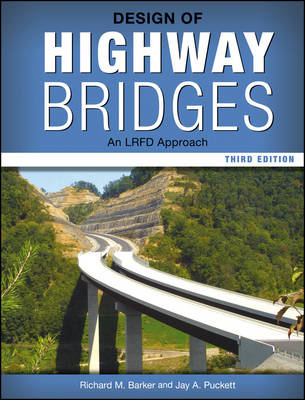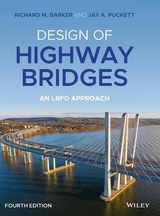
Design of Highway Bridges
John Wiley & Sons Ltd (Verlag)
978-0-470-90066-6 (ISBN)
- Titel erscheint in neuer Auflage
- Artikel merken
The late RICHARD M. BARKER, PhD, PE, was Professor Emeritus of Civil and Environmental Engineering at Virginia Polytechnic Institute and State University. Dr. Barker spent more than fifty years as a structural designer, project engineer, researcher, and teacher. JAY A. PUCKETT, PhD, PE, is V. O. Smith Professor of Civil and Architectural Engineering at the University of Wyoming and President of BridgeTech, Inc., a consulting firm that specializes in software development for bridge engineering. With over thirty years of experience in bridge research and development, he has developed software for the analysis and rating of bridge systems that is currently in use at over forty transportation agencies. Dr. Puckett was a subconsultant to Michael Baker Jr. Inc. for the development of AASHTO's new rating and design systems (Virtis/Opis). His research has involved several National Academy NCHRP projects.
Preface xi Preface to the Second Edition xiii Preface to the First Edition xv PART I GENERAL ASPECTS OF BRIDGE DESIGN CHAPTER 1 INTRODUCTION TO BRIDGE ENGINEERING 3 1.1 A Bridge Is the Key Element in a Transportation System 3 1.2 Bridge Engineering in the United States 3 1.2.1 Stone Arch Bridges 3 1.2.2 Wooden Bridges 4 1.2.3 Metal Truss Bridges 6 1.2.4 Suspension Bridges 8 1.2.5 Metal Arch Bridges 10 1.2.6 Reinforced Concrete Bridges 12 1.2.7 Girder Bridges 13 1.2.8 Closing Remarks 14 1.3 Bridge Engineer Planner, Architect, Designer, Constructor, and Facility Manager 14 References 15 Problems 15 CHAPTER 2 SPECIFICATIONS AND BRIDGE FAILURES 17 2.1 Bridge Specifications 17 2.2 Implication of Bridge Failures on Practice 18 2.2.1 Silver Bridge, Point Pleasant, West Virginia, December 15, 1967 18 2.2.2 I-5 and I-210 Interchange, San Fernando, California, February 9, 1971 19 2.2.3 Sunshine Skyway, Tampa Bay, Florida, May 9, 1980 21 2.2.4 Mianus River Bridge, Greenwich, Connecticut, June 28, 1983 22 2.2.5 Schoharie Creek Bridge, Amsterdam, New York, April 5, 1987 24 2.2.6 Cypress Viaduct, Loma Prieta Earthquake, October 17, 1989 25 2.2.7 I-35W Bridge, Minneapolis,Minnesota, August 1, 2007 26 2.2.8 Failures During Construction 30 References 30 Problems 31 CHAPTER 3 BRIDGE AESTHETICS 33 3.1 Introduction 33 3.2 Nature of the Structural Design Process 33 3.2.1 Description and Justification 33 3.2.2 Public and Personal Knowledge 34 3.2.3 Regulation 34 3.2.4 Design Process 35 3.3 Aesthetics in Bridge Design 36 3.3.1 Definition of Aesthetics 36 3.3.2 Qualities of Aesthetic Design 37 3.3.3 Practical Guidelines for Medium- and Short-Span Bridges 47 3.3.4 Computer Modeling 55 3.3.5 Web References 56 3.3.6 Closing Remarks on Aesthetics 59 References 59 Problems 60 CHAPTER 4 BRIDGE TYPES AND SELECTION 61 4.1 Main Structure below the Deck Line 61 4.2 Main Structure above the Deck Line 61 4.3 Main Structure Coincides with the Deck Line 64 4.4 Closing Remarks on Bridge Types 66 4.5 Selection of Bridge Type 66 4.5.1 Factors to Be Considered 66 4.5.2 Bridge Types Used for Different Span Lengths 69 4.5.3 Closing Remarks 72 References 72 Problems 73 CHAPTER 5 DESIGN LIMIT STATES 75 5.1 Introduction 75 5.2 Development of Design Procedures 75 5.2.1 Allowable Stress Design 75 5.2.2 Variability of Loads 76 5.2.3 Shortcomings of Allowable Stress Design 76 5.2.4 Load and Resistance Factor Design 77 5.3 Design Limit States 77 5.3.1 General 77 5.3.2 Service Limit State 79 5.3.3 Fatigue and Fracture Limit State 80 5.3.4 Strength Limit State 81 5.3.5 Extreme Event Limit State 81 5.4 Closing Remarks 82 References 82 Problems 82 CHAPTER 6 PRINCIPLES OF PROBABILISTIC DESIGN 83 6.1 Introduction 83 6.1.1 Frequency Distribution and Mean Value 83 6.1.2 Standard Deviation 83 6.1.3 Probability Density Functions 84 6.1.4 Bias Factor 85 6.1.5 Coefficient of Variation 85 6.1.6 Probability of Failure 86 6.1.7 Safety Index 87 6.2 Calibration of LRFD Code 89 6.2.1 Overview of the Calibration Process 89 6.2.2 Calibration Using Reliability Theory 89 6.2.3 Calibration of Fitting with ASD 93 6.3 Closing Remarks 94 References 94 Problems 94 CHAPTER 7 GEOMETRIC DESIGN CONSIDERATIONS 95 7.1 Introduction to Geometric Roadway Considerations 95 7.2 Roadway Widths 95 7.3 Vertical Clearances 96 7.4 Interchanges 96 References 97 Problem 97 PART II LOADS AND ANALYSIS CHAPTER 8 LOADS 101 8.1 Introduction 101 8.2 Gravity Loads 101 8.2.1 Permanent Loads 101 8.2.2 Transient Loads 102 8.3 Lateral Loads 114 8.3.1 Fluid Forces 114 8.3.2 Seismic Loads 118 8.3.3 Ice Forces 122 8.4 Forces Due to Deformations 127 8.4.1 Temperature 127 8.4.2 Creep and Shrinkage 129 8.4.3 Settlement 129 8.5 Collision Loads 129 8.5.1 Vessel Collision 129 8.5.2 Rail Collision 129 8.5.3 Vehicle Collision 129 8.6 Blast Loading 129 8.7 Summary 130 References 130 Problems 131 CHAPTER 9 INFLUENCE FUNCTIONS AND GIRDER-LINE ANALYSIS 133 9.1 Introduction 133 9.2 Definition 133 9.3 Statically Determinate Beams 134 9.3.1 Concentrated Loads 134 9.3.2 Uniform Loads 136 9.4 Muller Breslau Principle 137 9.4.1 Betti s Theorem 137 9.4.2 Theory of Muller Breslau Principle 138 9.4.3 Qualitative Influence Functions 139 9.5 Statically Indeterminate Beams 139 9.5.1 Integration of Influence Functions 142 9.5.2 Relationship between Influence Functions 143 9.5.3 Muller Breslau Principle for End Moments 145 9.5.4 Automation by Matrix Structural Analysis 146 9.6 Normalized Influence Functions 147 9.7 AASHTO Vehicle Loads 149 9.8 Influence Surfaces 156 9.9 Summary 157 References 157 Problems 157 CHAPTER 10 SYSTEM ANALYSIS INTRODUCTION 161 10.1 Introduction 161 10.2 Safety of Methods 162 10.2.1 Equilibriumfor Safe Design 162 10.2.2 Stress Reversal and Residual Stress 165 10.2.3 Repetitive Overloads 165 10.2.4 Fatigue and Serviceability 169 10.3 Summary 170 References 170 Problem 170 CHAPTER 11 SYSTEM ANALYSIS GRAVITY LOADS 171 11.1 Slab Girder Bridges 171 11.2 Slab Bridges 194 11.3 Slabs in Slab Girder Bridges 198 11.4 Box-Girder Bridges 206 11.5 Closing Remarks 212 References 213 Problems 213 CHAPTER 12 SYSTEM ANALYSIS LATERAL, TEMPERATURE, SHRINKAGE, AND PRESTRESS LOADS 215 12.1 Lateral Load Analysis 215 12.1.1 Wind Loads 215 12.1.2 Seismic Load Analysis 216 12.2 Temperature, Shrinkage, and Prestress 221 12.2.1 General 221 12.2.2 Prestressing 221 12.2.3 Temperature Effects 222 12.2.4 Shrinkage and Creep 225 12.3 Closing Remarks 225 References 225 PART III CONCRETE BRIDGES CHAPTER 13 REINFORCED CONCRETE MATERIAL RESPONSE AND PROPERTIES 229 13.1 Introduction 229 13.2 Reinforced and Prestressed Concrete Material Response 229 13.3 Constituents of Fresh Concrete 230 13.4 Properties of Hardened Concrete 232 13.4.1 Short-Term Properties of Concrete 232 13.4.2 Long-Term Properties of Concrete 238 13.5 Properties of Steel Reinforcement 242 13.5.1 Nonprestressed Steel Reinforcement 242 13.5.2 Prestressing Steel 244 References 246 Problems 246 CHAPTER 14 BEHAVIOR OF REINFORCED CONCRETE MEMBERS 249 14.1 Limit States 249 14.1.1 Service Limit State 249 14.1.2 Fatigue Limit State 252 14.1.3 Strength Limit State 255 14.1.4 Extreme Event Limit State 256 14.2 Flexural Strength of Reinforced Concrete Members 257 14.2.1 Depth to Neutral Axis for Beams with Bonded Tendons 257 14.2.2 Depth to Neutral Axis for Beams with Unbonded Tendons 259 14.2.3 Nominal Flexural Strength 260 14.2.4 Ductility,Maximum Tensile Reinforcement, and Resistance Factor Adjustment 262 14.2.5 Minimum Tensile Reinforcement 264 14.2.6 Loss of Prestress 265 14.3 Shear Strength of Reinforced Concrete Members 270 14.3.1 Variable-Angle Truss Model 271 14.3.2 Modified Compression Field Theory 272 14.3.3 Shear Design Using Modified Compression Field Theory 278 14.4 Closing Remarks 289 References 289 Problems 290 CHAPTER 15 CONCRETE BARRIER STRENGTH AND DECK DESIGN 291 15.1 Concrete Barrier Strength 291 15.1.1 Strength of Uniform Thickness Barrier Wall 291 15.1.2 Strength of Variable Thickness Barrier Wall 293 15.1.3 Crash Testing of Barriers 293 15.2 Concrete Deck Design 293 References 311 Problems 311 CHAPTER 16 CONCRETE DESIGN EXAMPLES 313 16.1 Solid Slab Bridge Design 313 16.2 T-Beam Bridge Design 321 16.3 Prestressed Girder Bridge 340 References 359 PART IV STEEL BRIDGES CHAPTER 17 STEEL BRIDGES 363 17.1 Introduction 363 17.2 Material Properties 363 17.2.1 Steelmaking Process: Traditional 363 17.2.2 Steelmaking Process: Mini Mills 365 17.2.3 Steelmaking Process: Environmental Considerations 365 17.2.4 Production of Finished Products 365 17.2.5 Residual Stresses 365 17.2.6 Heat Treatments 366 17.2.7 Classification of Structural Steels 366 17.2.8 Effects of Repeated Stress (Fatigue) 370 17.2.9 Brittle Fracture Considerations 372 17.3 Summary 374 References 374 Problem 375 CHAPTER 18 LIMIT STATES AND GENERAL REQUIREMENTS 377 18.1 Limit States 377 18.1.1 Service Limit State 377 18.1.2 Fatigue and Fracture Limit State 378 18.1.3 Strength Limit States 389 18.1.4 Extreme Event Limit State 389 18.2 General Design Requirements 390 18.2.1 Effective Length of Span 390 18.2.2 Dead-Load Camber 390 18.2.3 Minimum Thickness of Steel 390 18.2.4 Diaphragms and Cross Frames 390 18.2.5 Lateral Bracing 390 References 391 Problems 391 CHAPTER 19 STEEL COMPONENT RESISTANCE 393 19.1 Tensile Members 393 19.1.1 Types of Connections 393 19.1.2 Tensile Resistance Specifications 393 19.1.3 Strength of Connections for Tension Members 396 19.2 Compression Members 396 19.2.1 Column Stability Behavior 396 19.2.2 Inelastic Buckling Behavior 398 19.2.3 Compressive Resistance Specifications 399 19.2.4 Connections for Compression Members 401 19.3 I-Sections in Flexure 402 19.3.1 General 402 19.3.2 Yield Moment and Plastic Moment 405 19.3.3 Stability Related to Flexural Resistance 411 19.3.4 Limit States 421 19.3.5 Summary of I-Sections in Flexure 424 19.3.6 Closing Remarks on I-Sections in Flexure 424 19.4 Shear Resistance of I-Sections 427 19.4.1 Beam Action Shear Resistance 427 19.4.2 Tension Field Action Shear Resistance 429 19.4.3 Combined Shear Resistance 431 19.4.4 Shear Resistance of UnstiffenedWebs 432 19.5 Shear Connectors 432 19.5.1 Fatigue Limit State for Stud Connectors 433 19.5.2 Strength Limit State for Stud Connectors 434 19.6 Stiffeners 438 19.6.1 Transverse Intermediate Stiffeners 438 19.6.2 Bearing Stiffeners 440 References 441 Problems 442 CHAPTER 20 STEEL DESIGN EXAMPLES 443 20.1 Noncomposite Rolled Steel Beam Bridge 443 20.2 Composite Rolled Steel Beam Bridge 452 20.3 Multiple-Span Composite Steel Plate Girder Beam Bridge 461 References 499 APPENDIX A INFLUENCE FUNCTIONS FOR DECK ANALYSIS 501 APPENDIX B TRANSVERSE DECK MOMENTS PER AASHTO APPENDIX A4 503 APPENDIX C METAL REINFORCEMENT INFORMATION 505 APPENDIX D REFINED ESTIMATE OF TIME-DEPENDENT LOSSES 507 References 512 APPENDIX E NCHRP 12-33 PROJECT TEAM 513 Task Groups 513 APPENDIX F LIVE-LOAD DISTRIBUTION RIGIDMETHOD 515 INDEX 517
| Erscheint lt. Verlag | 22.3.2013 |
|---|---|
| Verlagsort | Chichester |
| Sprache | englisch |
| Maße | 220 x 285 mm |
| Gewicht | 1466 g |
| Themenwelt | Technik ► Bauwesen |
| ISBN-10 | 0-470-90066-0 / 0470900660 |
| ISBN-13 | 978-0-470-90066-6 / 9780470900666 |
| Zustand | Neuware |
| Haben Sie eine Frage zum Produkt? |
aus dem Bereich



